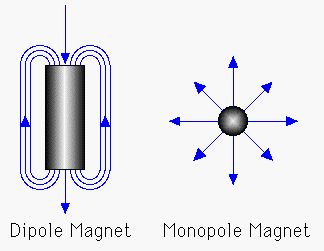


Along each edge, the current on one side flows in one direction and on the other side in the opposite direction. This obviously cancels out both currents, which shows that a monopole does not require any external current, just like a magnetic dipole doesn't. The only thing which is needed is a closed conductive surface, so that the virtual vortices of virtual current can produce a real magnetic field.

To push the fields in the right direction, we need a radial magnetic field. This is most easily created by another monopole placed around (or inside) the object. The above mentioned cubical arrangement of coils works fine for this. In my experiments I have used coils with a side of one meter, linked together by an supporting aluminium framework to build a monopolar charging unit. When a sufficiently strong current is applied, the monopolar fields force the virtual vortices of the object placed in the interior chamber to align and the object becomes a permanent monopole.
The most important variable in this process is the strength of the field, which is proportional to the current. One way to improve the efficiency is to use a single strong pulse instead of a constant current. One arrangement I have used is a bank of capacitators, whose energy is released by short-circuiting them. This places great demands on the cooling and structural stability of the system, which limits their use somewhat (superconducting coils would ameliorate the heat problem a great deal). Care must also to be taken so that the fields are exactly radial, since if the alignment of the coils is not correct, a powerful electromagnetic vortex will result which will destroy the object and possibly damage the coils. Current pulses are safer in this respect, but has an unfortunate tendency to cause electric discharges between different parts of the system if not properly insulated.
One unusual effect of monopoles is that they produce electric fields when moving. A monopole bullet will create such a strong electric field that it becomes surrounded by toroidal arc lightning, increasing its damage potential (especially against electronic targets). If a monopolar object is placed close to a current-carrying wire, it will begin to orbit it. This could be used as an elegant motor (or generator) with no need for other moving parts than a flywheel with fixed monopoles placed around the electrical axis.
Monopole dust will always move to the north or south when released, making it a rather simple compass. Daedalus [1] has pointed out that if there are natural monopoles, they will congregate close to the magnetic poles (this may explain why no natural monopoles have so far been found in nature [5]).
One of the more theoretical uses of monopoles would be to induce controlled fusion of a plasma. A heavy monopole (like a monopolarly charged atomic nucleus) injected into a hydrogen plasma would force the protons to orbit itself. If a strong current is led along the axis of a tokamak reactor, the monopoles would congregate within the plasma torus and stabilise it.
However, the most practical use of the monopoles is to contain or isolate fields of ether. As the magnetic flux lines leave an outward- monopole, they remove ether from the interior until the ether pressure difference equals the transport. An inward monopole will store ether from the surroundings. Care must be taken to insure the mechanical stability, I have in several experiments found that highly magnetic but structurally weak objects (like cast iron spheres) when magnetised too much store too much ether and break, releasing it as explosive energy. I also postulate that a sufficiently strong outward field could at least theoretically cause the monopole to collapse into itself, perhaps forming neutronium or a black hole. However, at the energies which I have experimented, this has not happened.
Ether storage monopoles are very convenient. After being magnetised, they are placed in an area with a strong etheric field, where they absorb it. They can then be stored indefinitely, and the ether is released when they are demagnetised. This doesn't need to be done with a full monopolar charging unit, it can be done by simply placing them in a strong normal magnetic field which dipolarly magnetises them and thus releases the ether (this of course requires the monopole to be made of a magnetic material, not just a conductor).
The monopole chamber is another useful design I have found. By magnetising a spherical metal chamber with an outward field (or by building walls made of linked coils), the chamber becomes filled with an etheric vacuum. This has proven to be a very strong barrier against outside attacks, especially electromagnetic and etheric ones. It also severely weakens etheric patterns inside, which makes long- term exposure a health hazard. I have however plans to build a double-walled chamber, where a second, oppositely charged chamber is placed concentric inside the outer chamber. This would create an ether-neutral field, and make the interior completely safe for normal life.
[1] Daedalus, New Scientist, 3 December 1946
[2] Daedalus, New Scientist, 10 September 1970
[3] Dr Epsilon, Wireless World December 1978, p.67
[4] Mr J. Middlehurst, Wireless World September 1979, p. 82
[5] Dr H. H. Kolm, Science Journal September 1968, p. 60